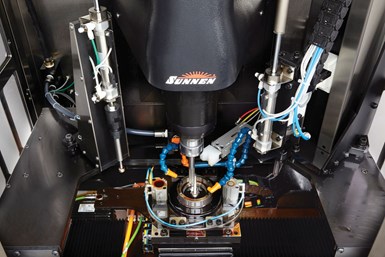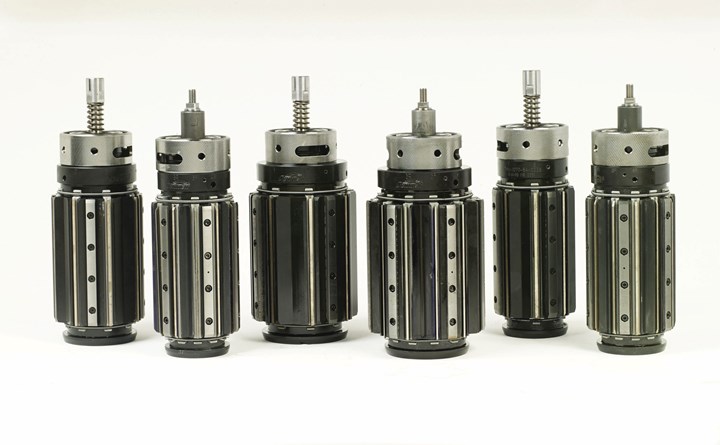
According to Sunnen, honing is typically required to achieve bore diameter tolerances of ±0.0002” or tighter with high-quality surface finishes. (Photo Credits: Sunnen Products Co.)
As one of the most common machining operations, holemaking presents manufacturers with plenty of options. Depending on bore diameter and surface finish tolerance, a shop might choose drilling, milling, electrical discharge machining (EDM) or a combination of those CNC machining processes and achieve quality results. For example, the hole created by a 0.5-inch drill might range from ±0.002 inch or be as much as 0.006-inch oversized, but a subsequent reaming operation can produce a smoother surface finish and a hole diameter within ±0.0002 inch. Reaming or boring milled holes can achieve similar results, while EDM is even more precise, producing a bore diameter within ±0.0005 inch.
However, there are good reasons to turn to honing for applications with the most stringent requirements for surface finish and precision. According to Sunnen, a manufacturer of honing equipment that provided the information for this article, holes formed via EDM typically require further processing to smooth surfaces. The process is also relatively slow. Optimized milling processes followed by boring or reaming may produce high-quality results, but not always consistently. Honing achieves all three goals: That is, the process consistently and reliably achieves bore diameter tolerances of ±0.0002" or tighter with high-quality surface finishes.
Honing is a sizing and finishing operation in which a revolving tool (mandrel), fitted with abrasives, strokes in and out of a bore. During the process, the abrasives are expanded, removing minute amounts of material to bring the hole to its proper size and finish. The resulting finish consists of microscopic peaks and valleys arranged in a crisscross or “crosshatch” pattern. The valleys enable oil retention between mating components during operation, such as pistons within an engine cylinder.
Although the process has been performed for many years, honing technology has evolved, and some manufacturers still have questions about it. Here are five of the most common:
1. What applications commonly call for honing? Engine cylinders and cylinder sleeves require honing for proper piston ring sealing. Diesel engine fuel system components are often honed because honing enables tighter control of the clearance between the bore and its mating part. The resulting higher fuel system pressure means more fuel is atomized and less unspent fuel is used, resulting in improved fuel efficiency and engine performance as well as lower carbon emissions.
Cartridge valves — used in hydraulic applications such as heavy equipment, agricultural machinery, and aerospace flight and landing gear control systems — are typically honed. This provides tight clearances between the valve body and spool to reduce the sealing area required.
Honing also improves the bore diameter size and surface finish of gun barrels prior to the rifling operation. This ensures uniform rifling for a better shot. The process is also useful for gears, small engines, brake drums, compressors, oil and gas flow meter tubing, and many other applications.

Tooling for honing is selected based on application requirements.
2. What unfavorable bore conditions can honing remedy? Examples include bore diameter size, bellmouth, waviness, taper, rainbow, barrel shape, reamer chatter, boring marks and out-of-round holes. The improved shape of the bore after honing almost always results in mating components operating more quietly and efficiently. Honing can correct errors caused by previous machining processes because it does not require chucking or alignment and is indifferent to bore length.
Other machining processes, such as grinding and boring, might fracture the metal’s subsurface to a depth of 0.002 inch. In addition, tool wear can cause work-hardening of the bore surface during machining. Honing is a gentler process, generating very little heat so as not to distort the bore.
3. What types of surface finishes can honing achieve? Surface finish, texture and appearance can be precisely controlled. The angle of the crosshatch pattern can be adjusted by varying the spindle speed and stroke speed of the honing tool. Some applications call for a steep crosshatch angle in the bore, while others require a shallow angle. The depth or roughness of the crosshatch pattern depends on the relative size of the abrasive grit in the honing stone. The larger the grit, the rougher the finish. A mirror finish with almost imperceptible surface texture can be achieved with very fine grit abrasives.
Honing can correct errors caused by previous machining processes.
4. What is involved in establishing an effective, consistent honing process? Like CNC machining, a number of questions must be answered when developing an optimized honing process. What is the part material, size and shape? What is the production volume? How much material needs to be removed? What are the finished workpiece bore tolerances and surface finish requirements? Answers to those and other questions determine the proper machine, fixtures, tooling, abrasives and honing oils or coolants, as well as honing process parameters such as spindle and stroking speeds and feed rate. The honing stone is selected based upon the type of material to be honed, tolerances to be achieved and the amount of material to be removed. There are as many types of abrasive honing stones available as there are types of milling or turning cutters, differentiated by grit material, grit size and bonding agent.

Like other machining operations, honing lends itself to robotic automation for high-volume applications.
5. How does lubrication affect honing? Honing oils and water-based coolants provide needed lubrication, washing away cut material and bringing new abrasive grit to the surface of the stones to maintain optimum cutting action. Quality oils, saturated with surface active agents, provide the necessary lubricity to increase honing pressure and use harder abrasives at faster cutting rates. Similarly, lubricity agents combined with sulfur extreme-pressure additives prevent workpiece welding and tearing while keeping stones clean, resulting in a very consistent surface finish. Specially formulated honing fluids are also are available for use in severe applications in which problems such as galling can occur. Honing oils are available in many different formulations with various levels of viscosity. Environmentally friendly oils that are 100%-vegetable-based are an option.
Read Next
What is CNC Peel Grinding?
It resembles single-point turning on a lathe because, similar to a lathe’s tool, the grinding wheel moves in the X and Z axes to grind contours, diameters and other features.
Read More5 Grinding Considerations for Improving Surface Finish
Improving surface finish can be done by making adjustments to one or more of these points: operational parameters, wheel dressing, grit size, coolant delivery and machine condition.
Read MoreDo You Have Single Points of Failure?
Plans need to be in place before a catastrophic event occurs.
Read More



















.png;maxWidth=970;quality=90)